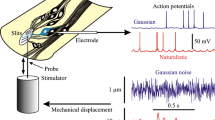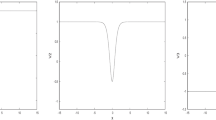Summary
Computer simulation of a relatively simple model can reproduce the main characteristics of the firing patters of some nerve cells. The abdominal stretch receptor of the crayfish has provided an analogous biological model. Synaptic input impulses were simulated by randomly distributed, short lasting transmembrane current pulses. Under these experimental conditions the stretch receptor neurone largely behaved as predicted by the computer simulations.
Similar content being viewed by others
References
Brown, M. C., and R. B. Stein: Quantitative studies on the slowly adapting stretch receptor of the crayfish. Kybernetik 3, 175–185 (1966).
Eide, E., L. Fedina, J. Jansen, A. Lundberg, and L. Vyklicky: Unitary excitatory postsynaptic potentials in Clarke's column neurones. Nature (Lond.) 215, 1176–1177 (1967).
Fuortes, M. G. F., and F. Mantegazzini: Interpretation of the repetitive firing of nerve cells. J. gen. Physiol. 45, 1163–1179 (1962).
Goldberg, J. M., H. O. Adrian, and F. D. Smith: Response of neurons of the superior olivary complex of the cat to acoustic stimuli of long duration. J. Neurophysiol. 27, 706–749 (1964).
—, and D. D. Greenwood: Response of neurons of the dorsal and posteroventral cochlear nuclei of the cat to acoustic stimuli of long duration. J. Neurophysiol. 29, 72–93 (1966).
Harreveld, A. van: A physiological solution for fresh water crustaceans. Proc. Soc. exp. Biol. (N.Y.) 34, 428–432 (1936).
Jansen, J. K. S., K. Nicolaysen, and T. Rudjord: Discharge pattern of neurons of the dorsal spinocerebellar tract activated by static extension of primary endings of muscle spindles. J. Neurophysiol. 29, 1061–1086 (1966).
Noble, D., and R. B. Stein: The threshold conditions for initiation of action potentials by excitable cells. J. Physiol. (Lond.) 187, 129–162 (1966).
Stein, R. B.: A theoretical analysis of neuronal variability. Biophys. J. 5, 173–194 (1965).
— Some model of neuronal variability. Biophys. J. 7, 37–68 (1967).
Terzuolo, C. A., and Y. Washizu: Relation between stimulus strengths, generator potential and impulse frequency in stretch receptor of Crustacea. J. Neurophysiol. 25, 56–66 (1962).
Walløe, L.: Transmission of information through a second order sensory neuron. In preparation (1969).
— J. K. S. Jansen, and K. Nygaard: A computer simulated model of a second order sensory neurone. Kybernetik 6, 130–141 (1969).
Werner, G., and V. B. Mountcastle: The variability of central neural acitivity in a sensory system, and its implication for the central reflection of sensory events. J. Neurophysiol. 26, 958–977 (1963).
Author information
Authors and Affiliations
Rights and permissions
About this article
Cite this article
Enger, P.S., Jansen, J.K.S. & Walløe, L. A biological model of the excitation of a second order sensory neurone. Kybernetik 6, 141–145 (1969). https://doi.org/10.1007/BF00274107
Received:
Issue Date:
DOI: https://doi.org/10.1007/BF00274107




